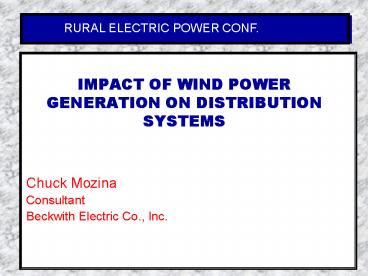IMPACT OF WIND POWER GENERATION ON DISTRIBUTION SYSTEMS - PowerPoint PPT Presentation
1 / 26
Title:
IMPACT OF WIND POWER GENERATION ON DISTRIBUTION SYSTEMS
Description:
IMPACT OF WIND POWER GENERATION ON DISTRIBUTION SYSTEMS Chuck Mozina Consultant Beckwith Electric Co., Inc. * 07/16/96 * ## * 07/16/96 * ## * 07/16/96 * ## * 07/16/96 ... – PowerPoint PPT presentation
Number of Views:194
Avg rating:3.0/5.0
Title: IMPACT OF WIND POWER GENERATION ON DISTRIBUTION SYSTEMS
1
IMPACT OF WIND POWER GENERATION ON DISTRIBUTION
SYSTEMS
Chuck Mozina Consultant Beckwith Electric Co.,
Inc.
2
Brief DG History
- Until Public Utility Regulatory Policies Act
(PURPA) in 1978, U.S. utilities were not required
to interconnect with small generators. - - Started DG
- - Beckwith gets into the
interconnection protection business - - Hot until late 1980s when tax
incentive terminated - Late 1990s DG again hot
- - Driven by high utility rates and
de-regulation - - DGs can generator cheaper at
source of consumption - Peak Shaving and Load
Following - - Hot until early 2000s when
natural gas prices increased - Late 2000s Green Power drives resurgence of DGs
- - Regulates require utilities to
generator a portion of their - power from green sources.
- - Set high buy back rate key
driver for Distribution Wind Installations
3
Types of Wind Power Generators
- Induction
- Asynchronous
- Four Types of Wind Generator Design
4
Induction Wind Generator
- Induction
- Excitation provided externally
- Start up like a motor(no sync. equipment needed)
- Less costly than synchronous machines
- Limited in size to 500 KVA
5
DG Interconnection Protection
6
DG Interconnection Protection
7
Induction Generator Short Circuit Calculations
--- Voltage source in series with the direct axis
sub-transient inductance
That means for a 3-phase fault at the LV
terminals, it contributes approximately a maximum
symmetrical short-circuit current with a
magnitude equals to the induction generator
locked rotor current during the first cycle after
the fault.
8
Induction Generator Short Circuit Current
Decay 3-phase fault on MV bus
9
Induction Generator Ferroresonance
- Ferroresonance can take place between an
induction machine and pole top capacitors after
utility disconnection from feeder. Ferroresonance
can also occur on Synchronous Generators! - Generator is excited by pole top capacitors if
the reactive components of the generator and
aggregate capacitors are close. - This interplay produces non-sinusoidal waveforms
with high voltage peaks. This causes
transformers to saturate, the non-linearities
exacerbate the detection problem
10
FERRORESONANCENEW YORK FIELD TESTS 1989FIELD
TEST CIRCUIT
11
FERRORESONANCENEW YORK FIELD TESTS -198950KW
Induction DG, 9KW load, 100KVAR Capacitance and
Wye-Delta Interconnection TransformerA2.74 pu
B2.34 pu C2.92 pu
12
CONDITIONS FOR FERRORESONANCE
- DG Must be Separated From the Utility System
(islanded condition) - KW Load in the Island Must be Less than 3 Times
DG Rating - Capacitance Must be Greater Than 25 and Less Than
500 Percent of DG Rating - There Must be a Transformer in the Circuit to
Provide Nonlinearity
13
FERRORESONANCENEW YORK FIELD TESTS -198950KW
Induction DG, 9KW load, 100KVAR Capacitance and
Wye-Delta Interconnection TransformerA2.74 pu
B2.34 pu C2.92 puPROTECTION SOLUTION MEASURE
PEAK OVERVOLTAGE NOT RMS (59I)
14
Asynchronous Generator
VARS
- Asynchronous
- Static Power Converter (SPC) converts generator
frequency to system frequency - Generator asynchronously connected to power
system - IEEE P 929 and UL 1741 Provide Guidance on SPCs
15
Asynchronous GeneratorStatic Power Converter
(SPC)
- Some have Built-In Anti-Islanding Protection
- SPC tries to periodically change frequency
- If grid is hot, SPC cannot change the frequency
- If grid has tripped, the frequency moves and the
controller trips the machine - Difficult to test some utilities do not trust
and require other protection
16
DG Interconnection Protection
17
DG Interconnection Protection
18
DG Interconnection Protection
19
DG Interconnection Protection
Impact of Interconnection Transformer
- Ungrounded Primary Transformer Winding
- Overvoltage may be caused by Wind Generator when
ungrounded primary transformer windings are
applied (no ground source) and the Wind Generator
backfeeds once utility disconnects - Grounded Primary Transformer Winding
- Ground fault current contribution caused by Wind
Generator grounded primary transformer windings
during utility faults - Source feeder relaying and reclosers responding
to secondary ground faults within the Wind
Generator facility
20
Ungrounded Interconnection Transformers
Advantages
Provide no ground fault backfeed for fault at F1
F2. No ground current from breaker A for a
fault at F3.
Problems
Can supply the feeder circuit from an
underground source after substation breaker A
trips causing overvoltage
Low Voltage (SEC.)
High Voltage (PRI.)
Wind Generator
21
Grounded Primary Interconnection Transformers
Advantages
No ground current from breaker A for faults at
F3( ). No overvoltage for ground fault at
F1. No overvoltage for ground fault at F1.
2
Problems
Provides an unwanted ground current for supply
circuit faults at F1 and F2. Allows source
feeder relaying at A to respond to a secondary
ground fault at F3( ).
Low Voltage (SEC.)
High Voltage (PRI.)
Wind Generator
3
22
Interconnection Protection Placement Key
Protection Element 59I
23
Interconnection Protection Placement Key
Protection Element 59I
24
Interconnection Protection Placement Key
Protection Element 59I
25
CONCLUSIONS
- 1. Wind Power Generation Interconnected on
Distributions Systems Present Significant
Technical Problems and Potential Harzards - 2. There are No Standard Solutions Only
Choices with - Undersirable Drawbacks.
- 3. Over-Voltage 59I is Key Element to Detect
Ferroresonance - 4. When Developing Wind Interconnection
Protection the Technical Issues Raised in this
Paper Need to be Addresses
26
THE END
IMPACT OF WIND POWER GENERATION ON DISTRIBUTION
SYSTEMS QUESTIONS































